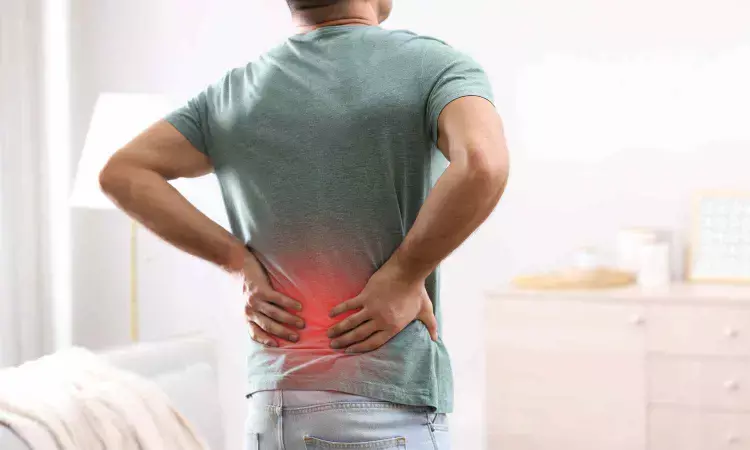- Home
- Medical news & Guidelines
- Anesthesiology
- Cardiology and CTVS
- Critical Care
- Dentistry
- Dermatology
- Diabetes and Endocrinology
- ENT
- Gastroenterology
- Medicine
- Nephrology
- Neurology
- Obstretics-Gynaecology
- Oncology
- Ophthalmology
- Orthopaedics
- Pediatrics-Neonatology
- Psychiatry
- Pulmonology
- Radiology
- Surgery
- Urology
- Laboratory Medicine
- Diet
- Nursing
- Paramedical
- Physiotherapy
- Health news
- Fact Check
- Bone Health Fact Check
- Brain Health Fact Check
- Cancer Related Fact Check
- Child Care Fact Check
- Dental and oral health fact check
- Diabetes and metabolic health fact check
- Diet and Nutrition Fact Check
- Eye and ENT Care Fact Check
- Fitness fact check
- Gut health fact check
- Heart health fact check
- Kidney health fact check
- Medical education fact check
- Men's health fact check
- Respiratory fact check
- Skin and hair care fact check
- Vaccine and Immunization fact check
- Women's health fact check
- AYUSH
- State News
- Andaman and Nicobar Islands
- Andhra Pradesh
- Arunachal Pradesh
- Assam
- Bihar
- Chandigarh
- Chattisgarh
- Dadra and Nagar Haveli
- Daman and Diu
- Delhi
- Goa
- Gujarat
- Haryana
- Himachal Pradesh
- Jammu & Kashmir
- Jharkhand
- Karnataka
- Kerala
- Ladakh
- Lakshadweep
- Madhya Pradesh
- Maharashtra
- Manipur
- Meghalaya
- Mizoram
- Nagaland
- Odisha
- Puducherry
- Punjab
- Rajasthan
- Sikkim
- Tamil Nadu
- Telangana
- Tripura
- Uttar Pradesh
- Uttrakhand
- West Bengal
- Medical Education
- Industry
Study Identifies 60 as Key Age Threshold for Increased Risk of Back Disorders

Spain: A recent study using data from the UK Biobank, involving over 74,000 individuals, has shed new light on the age-related risk of developing back disorders. The study of over eight years concluded that the risk of low back disorders (LBD) and dorsal disorders (DD) increases significantly after 60.
"Individuals aged 61-70 faced a 39% to 71% higher risk for LBD and a 31% to 74% higher risk for DD compared to those aged 40. However, there was no strong association between age and cervical disorders. The findings suggest that targeting individuals over 60 for preventive interventions could help reduce the risk of these conditions," the researchers reported in the European Spine Journal.
The study was conducted by Rubén López-Bueno, Department of Physical Medicine and Nursing, University of Zaragoza, Zaragoza, Spain, and colleagues to examine the prospective links between age and the risk of low back disorders, dorsal disorders, and cervical disorders and to identify a potential age threshold for an increased risk of back disorders.
For this purpose, the researchers used a prospective cohort from the UK Biobank, consisting of adults with no history of back disorders. , Using hospital register diagnoses, they examined the relationship between different age groups and the risk of back disorders. The associations were analyzed through restricted cubic splines, adjusting for factors such as sex, racial and ethnic background, tobacco use, Townsend Deprivation Index, alcohol consumption, educational attainment, employment status, self-reported health, diet quality, body mass index, medication use, physical activity, and handgrip strength.
Key Findings:
- The analytic sample included 74,191 participants (mean age 55.2 years; 57% women), followed up for 7.9 years.
- A total of 3,297 (4.3%) cases of incident low back disorders (LBD), 1,224 (1.6%) cases of dorsal disorders (DD), and 792 (1.0%) cases of cervical disorders (CD) were recorded.
- A curvilinear association between age and LBD was observed, with significantly higher risks at ages 61 (hazard ratio [HR] = 1.39) and 70 (HR = 1.71), compared to 40 years.
- Similarly, the association of age with DD showed a curvilinear pattern, with significant risks at ages 60 (HR = 1.31) and 70 (HR = 2.74).
- There was no significant association between age and cervical disorders (CD).
"Our findings revealed that the risk of low back disorders and dorsal disorders increases significantly after the age of 60, while there was no such association for cervical disorders," the researchers wrote.
"This suggests that targeting individuals over 60 for preventive interventions and health programs could be crucial in reducing the risk of LBD and DD in the aging population," they concluded.
Reference:
López-Bueno, R., Andersen, L., Núñez-Cortés, R. et al. Age-threshold for increased risk of developing back disorders: prospective cohort with 74 000 individuals from the UK Biobank. Eur Spine J (2025). https://doi.org/10.1007/s00586-025-08686-3
Dr Kamal Kant Kohli-MBBS, DTCD- a chest specialist with more than 30 years of practice and a flair for writing clinical articles, Dr Kamal Kant Kohli joined Medical Dialogues as a Chief Editor of Medical News. Besides writing articles, as an editor, he proofreads and verifies all the medical content published on Medical Dialogues including those coming from journals, studies,medical conferences,guidelines etc. Email: drkohli@medicaldialogues.in. Contact no. 011-43720751


